Good looking Austrian actor Viktor Staal (1909-1982) was the nice, a bit wooden star of many films of the Third Reich. Very popular were the two films in which he played the romantic interest of Zarah Leander.
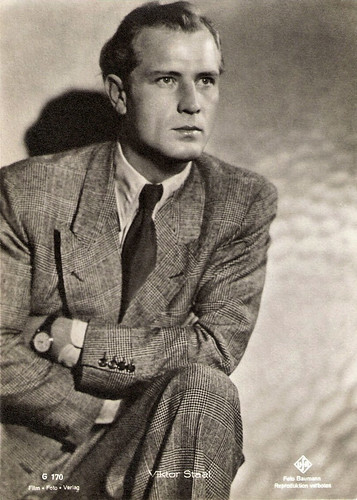
German postcard by Film-Foto-Verlag, no. G 170. Photo: Baumann / Ufa.
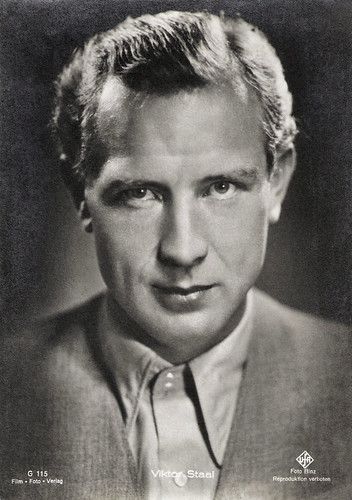
German postcard by Film-Foto-Verlag, no. G 115. Photo: Binz / Ufa.
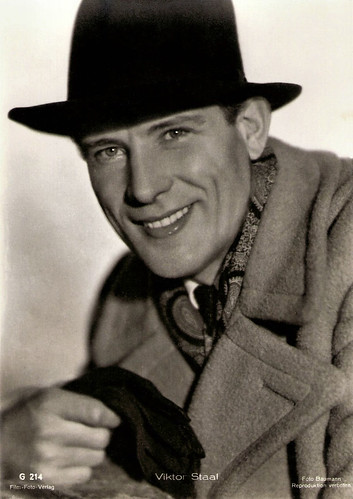
German postcard by Film-Foto-Verlag, no. G 214, 1941-1944. Photo: Baumann / Ufa.
Viktor Staal was born Rudolf Viktor Stiaßny in Frankstadt, Austria-Hungary (now Franstat pod Radhostem, Czech Republic) in 1909. He attended acting classes in Vienna and got his first engagements at small theatres. Later he acted at the Volkstheater Wien where he had his breakthrough as an actor.
He made his film debut in 1935 in a bit part in the operetta Eva/Eva, the Factory Girl (Johannes Riemann, 1935) starring Magda Schneider. He also played small roles in such films as Alles für die Firma/Everything For the Firm (Rudolf Meinert, 1935) with Felix Bressart, and Das Einmaleins der Liebe/Love's Arithmetic (Carl Hoffmann, 1935) with Luise Ullrich.
In 1936 he played his first leading role opposite Anny Ondra in the adventure Donogoo Tonka (Reinhold Schünzel, 1936). This Austrian-German coproduction brought him to the Ufa studio in Berlin. Ufa offered the big, blond and blue-eyed Austrian a contract, and during the next years Staal became a popular Ufa star with successful films like Waldwinter/Winter in the Woods (Fritz Peter Buch, 1936), Ein Mädel vom Ballett/A Girl from the Chorus (Carl Lamac, 1937) with Anny Ondra, and Brillanten/Rhinestones (Eduard von Borsody, 1937).
In seven films, he appeared opposite Hansi Knoteck, including Waldwinter (1936), Brillanten (1937), Ritt in die Freiheit/Ride to Freedom (Karl Hartl, 1937), the comedy Eine Nacht im Mai/A Night in May (Georg Jacoby, 1938) with Marika Rökk, and Gewitter im Mai/Storms in May (Hans Deppe, 1938). Knoteck would become his wife in 1940.
A huge hit was the romantic drama Zu neuen Ufern/To New Shores (Detlef Sierck/Douglas Sirk, 1937), in which he starred opposite Zarah Leander. Other popular films were the musical comedy Capriccio (Karl Ritter, 1938) starring Lilian Harvey, and the romantic drama Umwege zum Glück/Detours To Happiness (Fritz Peter Buch, 1939) with Lil Dagover.
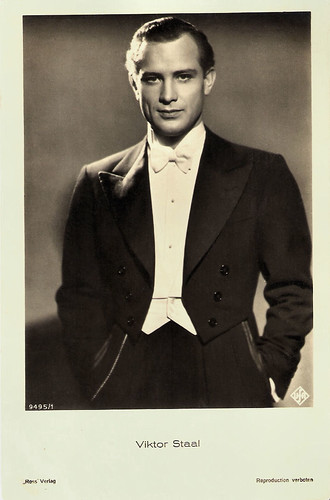
German postcard by Ross Verlag, no. 9495/1, 1935-1936. Photo: Ufa.
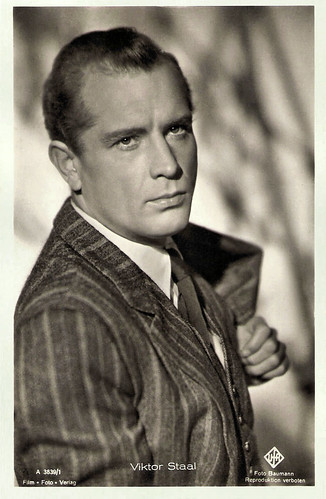
German postcard by Film-Foto-Verlag, no. A 3839/1, 1941-1944. Photo: Baumann / Ufa.
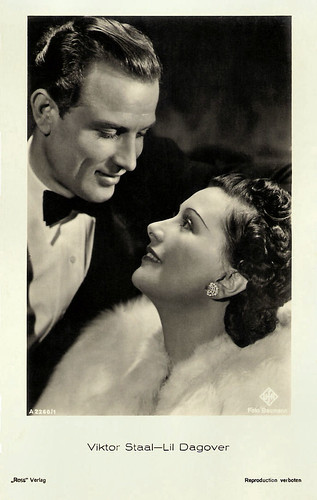
German postcard by Ross Verlag, no. A 2260/1, 1939-1940. Photo: Baumann / Ufa. Publicity still for Umwege zum Glück/Detours to happiness (Fritz Peter Buch, 1939) with Lil Dagover.

Big card by Ross Verlag. Photo: Hämmerer / Ufa. Publicity still for Frauen für Golden Hill/Women for Golden Hill (Erich Waschneck, 1938) with Kirsten Heiberg.
During World War II, Viktor Staal starred again with Zarah Leander in the slick romance Die grosse Liebe/The Great Love (Rolf Hansen, 1942) which became one of the greatest box office successes of the cinema of the Third Reich. He also played in productions like Zwielicht/Twilight (Rudolf van der Noss, 1940), the very funny musical comedy Hab' mich Lieb/Make Love To Me (Harald Braun, 1942) with Marika Rökk, the Henrik Ibsen adaptation Nora (Harald Braun, 1944), and the crime drama Via Mala (Josef von Báky, 1944-1948).
The original version of Via Mala was finished in March, 1944, but the propaganda ministry required director Von Baky to redo the ending. The censor accepted the film in March 1945, but changed his mind ten days later. Its official premiere was delayed until 16 January 1948.
After the war, Staal first worked on stage again at the Theater am Schiffbauerdamm in Berlin. During the war he had not appeared in notorious Nazi propaganda films so he was allowed to go on from his earlier successes in the film business, and would appear in 39 more films till 1977. He was still much in demand as the good-looking lover or husband in such films as Zwischen gestern und morgen/Between Yesterday and Tomorrow (Harald Braun, 1947) starring Hildegard Knef, Mathilde Möhring (Rolf Hansen, 1950) featuring Heidemarie Hatheyer, and Haus des Lebens/House of Life (Karl Hartl, 1952) with Cornell Borchers.
He grew out of the part though and played different roles in the thriller Spion für Deutschland/Spy for Germany (Werner Klingler, 1956) with Martin Held, the WW II drama Der Fuchs von Paris/The Fox of Paris (Paul May, 1957), and as Kara Ben Nemsi in the Karl May adaptation Die Sklavenkarawane/The Caravan of Slaves (Georg Marischka, Ramon Torrado, 1958).
When his film career dropped off he worked mainly for TV, such as in the well known series Landarzt Dr. Brock/Country Doctor Dr. Brock (1967-1969) with Rudolph Prack. To his last films belong Wilde Wasser/Wild Waters (Rudolf Schündler, 1962) with Marianne Hold, Der Jäger von Fall/The Hunter of Fall (Harald Reinl, 1974), and Die Standarte/The Standard (Ottokar Runze, 1977) with Jon Finch and Peter Cushing.
Viktor Staal passed away in 1982 in München (Munich), Germany. He and Hansi Knoteck had a son, Hannes (1942), who became an architect.
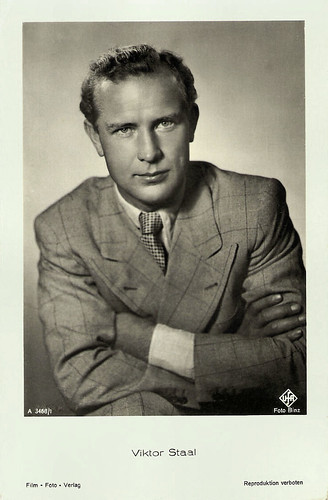
German postcard by Film-Foto-Verlag, no. A 3468/1, 1941-1944. Photo: Binz / Ufa.
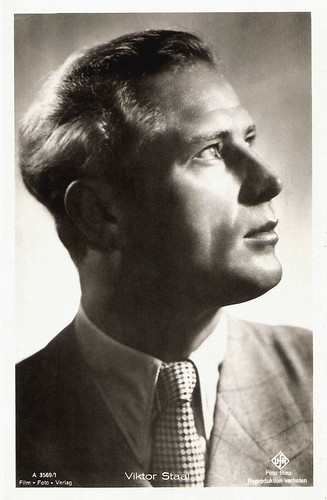
German postcard by Film-Foto-Verlag, no. A 3569/1, 1941-1944. Photo: Binz / Ufa.
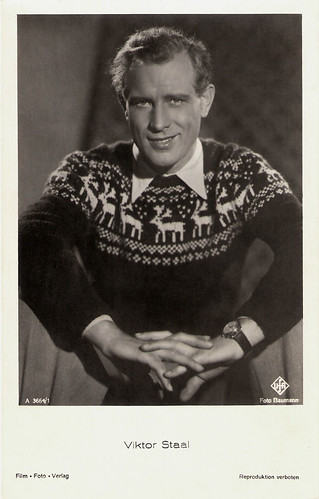
German postcard by Film-Foto-Verlag, no. A 3664/1, 1941-1944. Photo: Baumann / Ufa.
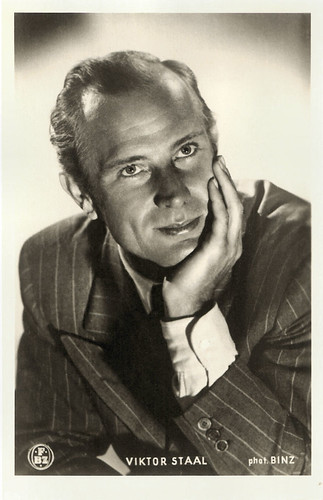
German postcard by F.B.Z. Photo: Binz.
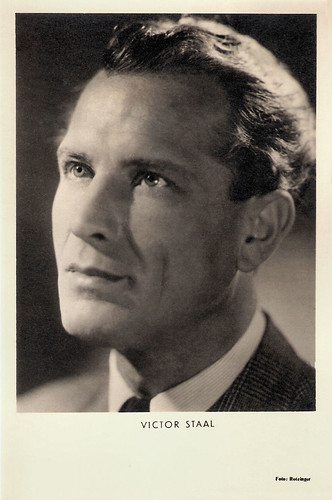
German postcard by Druck und Verlag Photo Kitt, München, no. 517. Photo: Rotzinger.
Sources: Stephanie D'heil (Steffi-Line) (German), Thomas Staedeli (Cyranos), Filmportal.de (German), Wikipedia and IMDb.

German postcard by Film-Foto-Verlag, no. G 170. Photo: Baumann / Ufa.

German postcard by Film-Foto-Verlag, no. G 115. Photo: Binz / Ufa.

German postcard by Film-Foto-Verlag, no. G 214, 1941-1944. Photo: Baumann / Ufa.
Big, Blond and Blue-eyed
Viktor Staal was born Rudolf Viktor Stiaßny in Frankstadt, Austria-Hungary (now Franstat pod Radhostem, Czech Republic) in 1909. He attended acting classes in Vienna and got his first engagements at small theatres. Later he acted at the Volkstheater Wien where he had his breakthrough as an actor.
He made his film debut in 1935 in a bit part in the operetta Eva/Eva, the Factory Girl (Johannes Riemann, 1935) starring Magda Schneider. He also played small roles in such films as Alles für die Firma/Everything For the Firm (Rudolf Meinert, 1935) with Felix Bressart, and Das Einmaleins der Liebe/Love's Arithmetic (Carl Hoffmann, 1935) with Luise Ullrich.
In 1936 he played his first leading role opposite Anny Ondra in the adventure Donogoo Tonka (Reinhold Schünzel, 1936). This Austrian-German coproduction brought him to the Ufa studio in Berlin. Ufa offered the big, blond and blue-eyed Austrian a contract, and during the next years Staal became a popular Ufa star with successful films like Waldwinter/Winter in the Woods (Fritz Peter Buch, 1936), Ein Mädel vom Ballett/A Girl from the Chorus (Carl Lamac, 1937) with Anny Ondra, and Brillanten/Rhinestones (Eduard von Borsody, 1937).
In seven films, he appeared opposite Hansi Knoteck, including Waldwinter (1936), Brillanten (1937), Ritt in die Freiheit/Ride to Freedom (Karl Hartl, 1937), the comedy Eine Nacht im Mai/A Night in May (Georg Jacoby, 1938) with Marika Rökk, and Gewitter im Mai/Storms in May (Hans Deppe, 1938). Knoteck would become his wife in 1940.
A huge hit was the romantic drama Zu neuen Ufern/To New Shores (Detlef Sierck/Douglas Sirk, 1937), in which he starred opposite Zarah Leander. Other popular films were the musical comedy Capriccio (Karl Ritter, 1938) starring Lilian Harvey, and the romantic drama Umwege zum Glück/Detours To Happiness (Fritz Peter Buch, 1939) with Lil Dagover.

German postcard by Ross Verlag, no. 9495/1, 1935-1936. Photo: Ufa.

German postcard by Film-Foto-Verlag, no. A 3839/1, 1941-1944. Photo: Baumann / Ufa.

German postcard by Ross Verlag, no. A 2260/1, 1939-1940. Photo: Baumann / Ufa. Publicity still for Umwege zum Glück/Detours to happiness (Fritz Peter Buch, 1939) with Lil Dagover.

Big card by Ross Verlag. Photo: Hämmerer / Ufa. Publicity still for Frauen für Golden Hill/Women for Golden Hill (Erich Waschneck, 1938) with Kirsten Heiberg.
Great Box-Office Success
During World War II, Viktor Staal starred again with Zarah Leander in the slick romance Die grosse Liebe/The Great Love (Rolf Hansen, 1942) which became one of the greatest box office successes of the cinema of the Third Reich. He also played in productions like Zwielicht/Twilight (Rudolf van der Noss, 1940), the very funny musical comedy Hab' mich Lieb/Make Love To Me (Harald Braun, 1942) with Marika Rökk, the Henrik Ibsen adaptation Nora (Harald Braun, 1944), and the crime drama Via Mala (Josef von Báky, 1944-1948).
The original version of Via Mala was finished in March, 1944, but the propaganda ministry required director Von Baky to redo the ending. The censor accepted the film in March 1945, but changed his mind ten days later. Its official premiere was delayed until 16 January 1948.
After the war, Staal first worked on stage again at the Theater am Schiffbauerdamm in Berlin. During the war he had not appeared in notorious Nazi propaganda films so he was allowed to go on from his earlier successes in the film business, and would appear in 39 more films till 1977. He was still much in demand as the good-looking lover or husband in such films as Zwischen gestern und morgen/Between Yesterday and Tomorrow (Harald Braun, 1947) starring Hildegard Knef, Mathilde Möhring (Rolf Hansen, 1950) featuring Heidemarie Hatheyer, and Haus des Lebens/House of Life (Karl Hartl, 1952) with Cornell Borchers.
He grew out of the part though and played different roles in the thriller Spion für Deutschland/Spy for Germany (Werner Klingler, 1956) with Martin Held, the WW II drama Der Fuchs von Paris/The Fox of Paris (Paul May, 1957), and as Kara Ben Nemsi in the Karl May adaptation Die Sklavenkarawane/The Caravan of Slaves (Georg Marischka, Ramon Torrado, 1958).
When his film career dropped off he worked mainly for TV, such as in the well known series Landarzt Dr. Brock/Country Doctor Dr. Brock (1967-1969) with Rudolph Prack. To his last films belong Wilde Wasser/Wild Waters (Rudolf Schündler, 1962) with Marianne Hold, Der Jäger von Fall/The Hunter of Fall (Harald Reinl, 1974), and Die Standarte/The Standard (Ottokar Runze, 1977) with Jon Finch and Peter Cushing.
Viktor Staal passed away in 1982 in München (Munich), Germany. He and Hansi Knoteck had a son, Hannes (1942), who became an architect.

German postcard by Film-Foto-Verlag, no. A 3468/1, 1941-1944. Photo: Binz / Ufa.

German postcard by Film-Foto-Verlag, no. A 3569/1, 1941-1944. Photo: Binz / Ufa.

German postcard by Film-Foto-Verlag, no. A 3664/1, 1941-1944. Photo: Baumann / Ufa.

German postcard by F.B.Z. Photo: Binz.

German postcard by Druck und Verlag Photo Kitt, München, no. 517. Photo: Rotzinger.
Sources: Stephanie D'heil (Steffi-Line) (German), Thomas Staedeli (Cyranos), Filmportal.de (German), Wikipedia and IMDb.
No comments:
Post a Comment